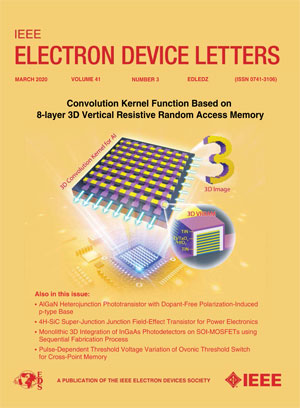Bilayer Ohmic Electrode Engineering in TaOX ReRAM Devices
IF 4.5
2区 工程技术
Q2 ENGINEERING, ELECTRICAL & ELECTRONIC
引用次数: 0
Abstract
TaOX ReRAM器件中的双层欧姆电极工程
$\text {TaO}_{\text {X}}$基于redox的随机存取存储器(ReRAM)是取代现有存储器技术的有力候选,具有低功耗,高耐用性和长保留时间。然而,降低开关能量和提高开关均匀性对实际应用至关重要。以前提高开关均匀性的努力已经损害了器件性能,导致低开/关比或高工作电压。在这项工作中,$\text {TaO}_{\text {X}}$ ReRAM采用双层欧姆电极(OE)进行设计,并基于OE的开关行为和材料特性探索特定OE厚度的开关机制。优化的Ti(2nm)/Ta(13nm)双层OE ReRAM具有较低的成型电压,平均SET (RESET)切换速度快11倍(6倍),平均开关能量低6倍,在长开关周期内电阻漂移低10倍,而其他器件性能指标没有下降。
本文章由计算机程序翻译,如有差异,请以英文原文为准。
求助全文
约1分钟内获得全文
求助全文
来源期刊

IEEE Electron Device Letters
工程技术-工程:电子与电气
CiteScore
8.20
自引率
10.20%
发文量
551
审稿时长
1.4 months
期刊介绍:
IEEE Electron Device Letters publishes original and significant contributions relating to the theory, modeling, design, performance and reliability of electron and ion integrated circuit devices and interconnects, involving insulators, metals, organic materials, micro-plasmas, semiconductors, quantum-effect structures, vacuum devices, and emerging materials with applications in bioelectronics, biomedical electronics, computation, communications, displays, microelectromechanics, imaging, micro-actuators, nanoelectronics, optoelectronics, photovoltaics, power ICs and micro-sensors.
 求助内容:
求助内容: 应助结果提醒方式:
应助结果提醒方式:


